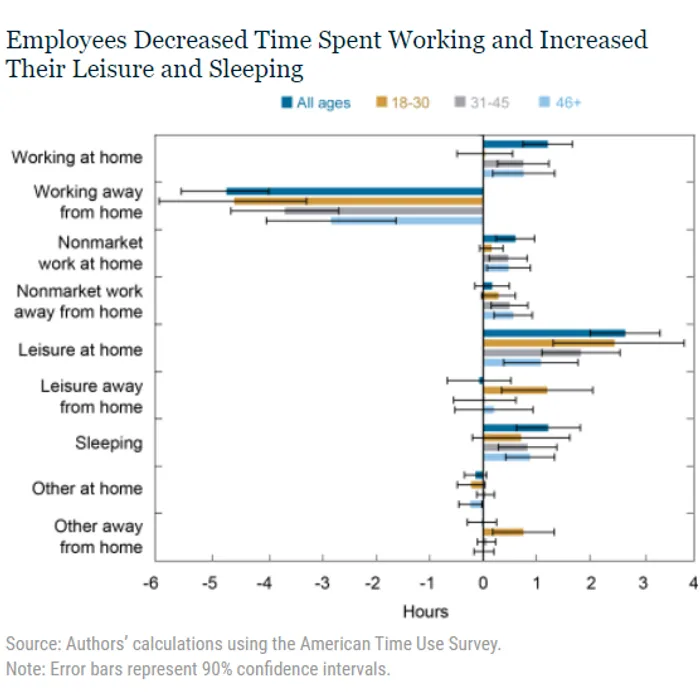The employment situation changed greatly due to the lockdowns during COVID-19. We are now more than two years since that kicked off and the work situation is still uncertain. While jobs, especially in the US, remain plentiful, there is a labor dispute taking place.
Unlike in the past, where blue collar workers fought with management, this is taking place among knowledge workers. Here we are seeing the concept of work from home versus the office being the battle lines.
Rarely a week will pass without some company making news in this area. It could come in the form of calling workers back to the office or in a reversal of that policy. Sometimes, like PayPal reversing its $2,500 thievery idea, it can all happen in the same week.
One thing about the passage of time, it provides ample data to start drawing some conclusions.
When it comes to remote work, it seems like most are in favor of it.
Fed Research Is Very Telling
The Federal Reserve Bank of NY did some research into what the post-COVID era work environment looks like. It also researched how people are handling it and what they are doing with their time.
Even as the pandemic has waned, more than 15 percent of full-time employees remain fully remote and an additional 30 percent work in hybrid arrangements.
This equates into a lot of time saved. Most of this comes from the absence of commuting.
Americans now spend 60 million fewer hours traveling to work each day.
That is a lot of time no longer spent sitting in a car, on a train, or in a bus. What this means is there are a lot of hours that can be utilized for either work or other purposes.
What did people do with all this excess time? The following chart shows the results.

As shown, the authors of the study noted:
First, we find a substantial fall in time spent working; the decrease in hours worked away from home is only partially offset by an increase in working at home.
Moreover, our findings help reconcile earlier work on commute times, which found that even though employees reported allocating 35 percent of their saved commute time to work, they spent fewer total hours in paid employment
Our results from the ATUS suggest that although individuals may have increased time working in the precise time-slot they used to commute, overall paid-work hours fell because of substitution toward other activities throughout the day.
This makes a great deal of sense. When employees have to commute, the idea of "hanging around" for another hour at the office can appeal to some people. If the opportunity for overtime is there, especially in lieu of battling rush hour traffic, one might take it.
When working from home, the answer seems to be a hard pass.
Second, we see notable increases in leisure time and sleeping. The rise in leisure was particularly pronounced among younger Americans, who reported spending more time at social events, eating at restaurants or bars, and exercising. Older age groups, on the other hand, tended to allocate more time to nonmarket work, such as activities related to childcare, the maintenance of the household, repairs, and meal preparation.
Here again, this should come as no surprise. When people leave work, they tend to engage in activities they prefer. It could be a shock to the developed world, but many people do have lives outside of work.
Employer-Employee Battle
This could be termed the Boomers vs. the Millennials. A lot of this discussion falls along demographic lines.
Companies headed by Boomers such as Apple and JP Morgan made headlines by their insistence on calling back employees. The policy of "we are all in this together" was quickly cast aside for the "come back to the office and let's return to normal" concept.
It was a move that was rejected by many.
Overall, the Boomers are going to lose this one. To start, they are on their last legs, holding onto what remains of their waning years of power. As they move into retirement, the younger generations, i.e. Millennials, start to step in.
Another factor in this is remote work is in perfect alignment with technological progress. The idea of Zoom meetings hit like a ton of bricks in 2020. Yet video conferencing technology was around for more than a decade. Companies were going digital long before COVID. In fact, FinTech is an area where software and applications took over.
The employment situation was one where the employers had a great deal of the power. This started with the Boomers entering the workforce in the 1970s and continues to today. It is a situation that is changing as many countries are facing a demographic crisis due to aging populations. This means there are less people to fill the jobs, especially as the older generations start to exit.
Top talent is going to make it a prerequisite. Companies that require a physical presence in the office are going to have those applicants pass them by. Once again, we have to keep an eye on who is gaining the power in this situation. If the trend continues where the employees have more choices, we can see how the employers are going to lose.
Another thing to keep in mind is the impact of Web 3.0, bringing cryptocurrency and blockchain into the discussion. If large numbers start to enjoy financial benefits from this arena, it could further tap the "job" market.
They say the only constant is change. In this instance, it is happening rather quickly and disrupting many things simultaneously.
If you found this article informative, please give an upvote and rehive.

gif by @doze

logo by @st8z